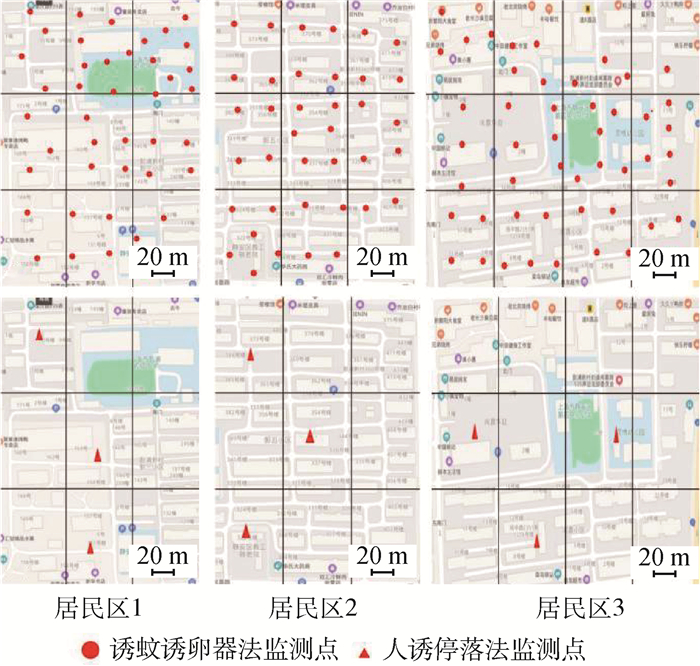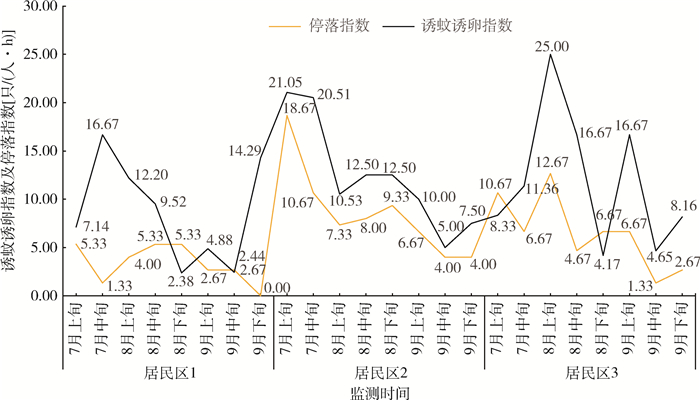扩展功能
文章信息
- 陈红, 周洲, 刘洪霞
- CHEN Hong, ZHOU Zhou, LIU Hong-xia
- 基于网格化的诱蚊诱卵器法与人诱停落法监测白纹伊蚊对照研究
- A comparative study based on gridded mosqito oviptrap method and human landing catch method monitoring Aedes mosquitoes
- 中国媒介生物学及控制杂志, 2023, 34(4): 451-456
- Chin J Vector Biol & Control, 2023, 34(4): 451-456
- 10.11853/j.issn.1003.8280.2023.04.002
-
文章历史
- 收稿日期: 2023-04-10
2 上海市疾病预防控制中心病媒生物防治科, 上海 200336
2 Department of Vector Control, Shanghai Municipal Center for Disease Control and Prevention, Shanghai 200336, China
登革热是全球流行最广泛、危害最严重的虫媒传染病[1]。全世界登革热发病率在近50年间急剧增加,重症登革热病例也随之增多[2]。近年来,登革热已成为我国的主要输入性传染病之一。同时,由于我国幅员辽阔,领土纵跨温带、亚热带和热带地区,大部分地区适宜于媒介伊蚊等传病蚊种的孳生,一旦有外来传染源的输入,极有可能引起本地的继发传播[3]。自2013年以来我国登革热疫情呈多点式暴发[4],2014年我国登革热大暴发达到1989年以来最高水平[5]。目前登革热缺乏有效的疫苗防控,而且登革热的发生具有突然性、传播迅速、发病率高等特点,一旦发生将对社会和经济造成极大的影响,因此,传播媒介的控制是预防登革热传播的关键。如何精准、有效地开展媒介伊蚊密度监测,采取预防性媒介控制措施,是预防登革热传播的关键。诱蚊诱卵器法是世界卫生组织(WHO)推荐用于登革热蚊媒监测的方法之一[6],对媒介伊蚊的监测有较高的特异性,有效降低了对人员鉴别能力的要求,该法操作简单,在国内外得到了广泛的应用[7-9]。此次研究旨在通过开展诱蚊诱卵器法和人诱停落法的现场对照研究,探索监测过程中影响诱蚊诱卵器法效果的影响因素,为建设以诱蚊诱卵器法为基础的预警机制提供依据。
1 材料与方法 1.1 数据来源来自上海市静安区2021年7-9月每月上、中、下旬在静安区的居民区开展现场诱蚊诱卵器法和人诱停落法对照研究数据。
1.2 调查点的选择综合考虑地理位置、场所类型、人口密度等因素,在辖区内选择相邻的3个面积、建筑年代、绿化比例接近的居民区,在外环境开展现场试验研究。
结合居民区实际纵横径,以九宫格形式划分为二级监测块(约90 m×60 m),以监测块为单位设置诱蚊诱卵器,每监测块布放不少于3只诱蚊诱卵器,每旬开展1次监测。每旬布放诱蚊诱卵器的当天,采用人诱停落法作为对照,每个居民区设置3个点位。具体点位如图 1所示。

|
| 图 1 2021年7-9月上海市静安区媒介伊蚊监测点位设置示意图 Figure 1 Schematic diagram of Aedes mosquito surveillance points in Jing'an District, Shanghai from July to September 2021 |
| |
将居民区内设置诱蚊诱卵器的绿化区域分为3个类型:屋侧绿化,指位于居民楼侧的绿化,附近有窗与室内相通;集中绿化,指居民区内较大规模的成片绿化,如花园、健身中心等;道路侧绿化,指居民区主干道两侧的装饰性绿化。见图 2。

|
| 图 2 2021年7-9月上海市静安区诱蚊诱卵器法监测环境类型示意图 Figure 2 Schematic diagram of environment types monitored by mosquito ovitrap method in Jing'an District, Shanghai from July to September 2021 |
| |
平行开展诱蚊诱卵器法和人诱停落法的现场试验研究,监测方法参照《病媒生物密度监测方法 蚊虫》(GB/T 23797-2020)。
1.3.1 人诱停落法每个居民区设置3个监测点,任意2个监测地点间隔距离100 m以上,在监测当日15:00-18:00选择避风遮阴处进行,诱集者暴露一侧小腿,利用电动吸蚊器收集被引诱的成蚊持续30 min,记录捕捉白纹伊蚊数量,同时记录诱蚊开始与结束的时间、地点、温度、湿度和风速。下雨、风力大于五级以上天气顺延,计算停落指数,作为评估指标。

|
在居民区的绿化带、草丛、树荫等蚊虫栖息地设置诱蚊诱卵器,间隔25~30 m放置1只,连续放置4 d,第4天检查,收集诱集的成蚊或蚊卵,记录阳性诱蚊诱卵器数量,计算诱蚊诱卵指数(MOI)。

|
采用Excel 2016软件对调查数据进行录入整理,采用SPSS 16.0软件对数据进行Kruskal-Wallis秩和检验、两因素方差分析、Pearson相关分析,P < 0.05为差异有统计学意义。
2 结果 2.1 各级监测块MOI差异 2.1.1 板块间差异共划定二级监测块30个,完成监测8次,设置诱蚊诱卵器131只/次,共计设置诱蚊诱卵器1 048只。居民区1共布放诱蚊诱卵器336只,回收333只,阳性29只,MOI为8.71;居民区2共布放诱蚊诱卵器320只,回收315只,阳性39只,MOI为12.38;居民区3共布放诱蚊诱卵器392只,回收376只,阳性45只,MOI为11.97,板块间MOI差异无统计学意义(χ2=2.750,P=0.253)。
2.1.2 板块内差异对居民区不同二级监测块多次监测结果进行分析,居民区1的MOI在不同二级块内差异有统计学意义(F=2.135,P=0.047),7-9月不同监测时间差异无统计学意义(F=1.557,P=0.168);居民区2的MOI在不同二级块内差异有统计学意义(F=2.168,P=0.044),不同时间差异无统计学意义(F=1.192,P=0.320);居民区3的MOI在不同二级块内无统计学意义(F=1.283,P=0.250),不同时间差异有统计学意义(F=2.527,P=0.021)。见表 1。

|
7-9月MOI分别为13.83、11.89和8.33,不同月份间差异无统计学意义(χ2=5.160,P=0.076);居民区内居住区MOI为12.24,社区学校区域为5.76,二者差异有统计学意义(χ2=6.657,P=0.010);诱蚊诱卵器设置在屋侧绿化的MOI为14.10,集中绿化区域为8.87,道路侧绿化为7.98,3类环境间差异有统计学意义(χ2=8.372,P=0.015);诱蚊诱卵器监测期间,降雨天数 < 2 d时MOI为13.28,≥2 d时为8.79,差异有统计学意义(χ2=4.218,P=0.047)。见表 2。

|
各板块MOI均值为11.00,停落指数均值为6.14只/(人·h),MOI和停落指数之比为2.15∶1;居民区1、2、3 MOI均值分别为8.69、12.45和11.88,停落指数均值分别为3.33、8.58和6.50只/(人·h),MOI与停落指数之比处于1∶1~3∶1,经Pearson相关分析,各板块MOI与人诱停落指数高度相关(r=0.549,P=0.005)。见表 3、图 3。

|

|
| 图 3 2021年7-9月上海市静安区各居民区诱蚊诱卵指数与人诱停落指数时间分布 Figure 3 Temporal distribution of mosquito ovitrap index and human landing index in residential areas in Jing'an District, Shanghai from July to September 2021 |
| |
近年来,上海市以建设“生态之城”为目标,构建了城乡公园体系、生态空间结构体系、自然保护地体系等多层次、多网络的生态体系,“十三五”期间上海市新建绿地逾6 000 hm2,城市公园数量增加到406座,新增立体绿化200万m2。绿化面积大幅增加的同时,蚊虫栖息和孳生的适宜环境极大丰富,为蚊虫监测和控制带来了很大的挑战。构建科学有效的蚊媒监测系统不但可以及时掌握监测区域的蚊虫种类、分布特征、季节消长等规律,更能为蚊媒传染病的防控、预测预警、风险评估提供科学精准的基础依据[10]。
在登革热的防控中,布雷图指数(BI)法是传统的媒介伊蚊幼虫密度监测方法之一,操作相对简单,但存在入户难、工作量大等问题[10]。诱蚊诱卵器法自2005年纳入《全国病媒生物监测方案(试行)》以来,因其操作简单、设计精巧、居民易接受而逐渐推广应用[11]。2017年,静安区首次提出基于诱蚊诱卵器法的网格化监测模式[12],扩大蚊虫监测覆盖面,提高监测代表性,此次研究是在网格化的基础上进一步探索诱蚊诱卵器法的应用,明确其影响因素,并以此为依据完善诱蚊诱卵器法在大型城市日常媒介伊蚊监测中的应用。
既往蚊虫监测提示,不同类型的场所,由于建筑特点、人员活动和绿化情况等的差异,其蚊虫密度差异有统计学意义[13-14]。而此次研究选择上述情况较为一致的同类型居民区开展,发现在不同居民区间,MOI差异无统计学意义,说明大小、绿化、建筑年代、房屋结构、人员活动情况接近的场所,整体媒介伊蚊密度也相近。因此,在实际开展监测时,应聚焦场所类型的多样性,可通过提前了解辖区场所的分布情况,同类型场所开展抽样监测,能有效减少人员投入。
传统监测中,为提高监测效率、减少投入,往往选择场所中部分区域实施监测,然而大的场所中,其蚊虫活动不均匀分布,人员活动密集区域、成片绿化区域周边蚊虫活动更为频繁,如现场环境中有临时性积水也会出现局部区域蚊虫密度高的情况,抽样布点法容易造成监测结果的偏差[15-17]。本次研究中也发现,同一居民区中按九宫格划分的二级监测块间MOI也会存在较大的差异,而相同监测块在不同时间也可能会有较大变化,网格化的监测模式能有效减少上述抽样选点造成的偏差。
在MOI影响因素方面,居民区内功能区域如社区学校等与居民区媒介伊蚊密度差异有统计学意义,放置诱蚊诱卵器的绿化区域,血源丰富的屋侧绿化和血源较少的道路侧绿化差异也有统计学意义。而监测期间降雨天数较多时媒介伊蚊密度显著低于降雨少时。因此,在使用诱蚊诱卵器法监测时,应关注大规模居民区中为便捷居民生活而配套的学校、医院、健身活动区、社区公园等功能性区域,应充分考虑不同场所类型媒介伊蚊孳生的差异,适当布点;优先选择血源较为丰富的屋侧绿化放置诱蚊诱卵器,监测周期如遇连续降雨可适当顺延。
人诱停落法是较为成熟的成蚊监测方法,也被公认是最灵敏的成蚊监测方法[18]。本研究在媒介伊蚊活动高峰期,尝试以停落指数为对照,验证诱蚊诱卵器法监测的有效性,同时为探索MOI阈值提供依据。诱蚊诱卵器法监测结果受成蚊密度和活动范围影响,监测第1天在监测场所内活动的成蚊对诱蚊诱卵器的影响时间最长,故此次采用诱蚊诱卵器布放第1天的停落指数作为对照。本研究为确保各监测居民区的环境较为一致,监测实施中会进行现场的孳生地查找和清理,且诱蚊诱卵器法监测的天数为4 d时间较短,故认为成蚊密度不会有较大幅度的变化。监测结果显示各居民区MOI和人诱停落指数监测结果有较高的一致性,提示诱蚊诱卵器法能较好地反映媒介伊蚊密度。2个指数比值在1∶1~3∶1,指数间比值可供制定常规监测诱蚊诱卵器预警值参考,但仍需开展重复性研究验证。
此次研究的局限性为以居民区为主开展研究,场所类型较为单一,后续仍需开展其他类型场所的现场研究以验证以上结果及比值的代表性,同时探索开展更大范围如街道(镇)、市等的区域网格化监测,并进一步加强与人口特点及活动情况的关联,聚焦重点人群,提高风险评估投入产出比,及时发现风险。
利益冲突 无
| [1] |
王永亮, 钱成, 郭运生, 等. 全球登革热流行势态及其影响评述[J]. 口岸卫生控制, 2018, 23(4): 20-26. Wang YL, Qian C, Guo YS, et al. Review on global dengue epidemiology with influence[J]. Port Health Control, 2018, 23(4): 20-26. DOI:10.3969/j.issn.1008-5777.2018.04.006 |
| [2] |
Schlagenhauf P, Weld L, Goorhuis A, et al. Travel-associated infection presenting in Europe (2008-12): An analysis of EuroTravNet longitudinal, surveillance data, and evaluation of the effect of the pre-travel consultation[J]. Lancet Infect Dis, 2015, 15(1): 55-64. DOI:10.1016/S1473-3099(14)71000-X |
| [3] |
汪圣强, 杨蒙蒙, 朱国鼎, 等. "一带一路"倡议下输入性蚊媒传染病的防控[J]. 中国血吸虫病防治杂志, 2018, 30(1): 9-13. Wang SQ, Yang MM, Zhu GD, et al. Control of imported mosquito-borne diseases under the Belt and Road Initiative[J]. Chin J Schisto Control, 2018, 30(1): 9-13. DOI:10.16250/j.32.1374.2017208 |
| [4] |
牟笛, 何泱霓, 陈秋兰, 等. 我国2016年登革热输入和本地病例流行病学特征比较[J]. 疾病监测, 2017, 32(3): 184-189. Mu D, He YN, Chen QL, et al. Comparison of epidemiological features between imported and indigenous dengue fever cases in China[J]. Dis Surveill, 2017, 32(3): 184-189. DOI:10.3784/j.issn.1003-9961.2017.03.004 |
| [5] |
Yue YJ, Sun JM, Liu XB, et al. Spatial analysis of dengue fever and exploration of its environmental and socio-economic risk factors using ordinary least squares: A case study in five districts of Guangzhou city, China, 2014[J]. Int J Infect Dis, 2018, 75: 39-48. DOI:10.1016/j.ijid.2018.07.023 |
| [6] |
World Health Organization. Dengue: Guidelines, for diagnosis, treatment, prevention and control[R]. Geneva: WHO, 2009: 120-122.
|
| [7] |
Barreto E, Resende MC, Eiras AE, et al. Evaluation of the baited ovitrap with natural attractant for monitoring Aedes spp. in Dili, capital of East Timor[J]. Cien Saude Colet, 2020, 25(2): 665-672. DOI:10.1590/1413-81232020252.12512018 |
| [8] |
Iyaloo DP, Facknath S, Bheecarry A. Seasonal changes in the distribution and relative abundance of the dengue vector, Aedes albopictus in two villages in Mauritius: Implications for a sterile release programme[J]. Afr Entomol, 2019, 27(1): 218-227. DOI:10.4001/003.027.0218 |
| [9] |
Mardiana, Wibowo A, Mahmudah. The difference existence of Aedes sp. larvae based on ovitrap locating in Samarinda city Indonesia[J]. Indian J Public Health Res Dev, 2018, 9(12): 1405-1409. DOI:10.5958/0976-5506.2018.02050.8 |
| [10] |
闫冬明, 黄坤, 赵春春, 等. 常用蚊虫监测方法和技术研究进展[J]. 中国媒介生物学及控制杂志, 2020, 31(1): 108-112. Yan DM, Huang K, Zhao CC, et al. Research advances in common methods and techniques for mosquito surveillance[J]. Chin J Vector Biol Control, 2020, 31(1): 108-112. DOI:10.11853/j.issn.1003.8280.2020.01.023 |
| [11] |
茌静, 古文媚, 陈戊申, 等. 3种媒介伊蚊监测方法在登革热疫点中的应用及相关性研究[J]. 中国媒介生物学及控制杂志, 2015, 26(5): 495-497, 508. Chi J, Gu WM, Chen WS, et al. Study on the correlation of three monitoring methods and application in epidemic area of dengue fever[J]. Chin J Vector Biol Control, 2015, 26(5): 495-497, 508. DOI:10.11853/j.issn.1003.4692.2015.05.016 |
| [12] |
陈红, 黄瑾, 单宁. 上海市静安区媒介伊蚊网格化监测模式研究[J]. 中国媒介生物学及控制杂志, 2021, 32(1): 89-93. Chen H, Huang J, Shan N. A study of grid-based model for Aedes vector surveillance in Jing'an district, Shanghai, China[J]. Chin J Vector Biol Control, 2021, 32(1): 89-93. DOI:10.11853/j.issn.1003.8280.2021.01.019 |
| [13] |
陈红, 单宁, 滕志翔, 等. 上海市静安区不同类型场所白纹伊蚊孳生现况调查[J]. 中华卫生杀虫药械, 2018, 24(4): 377-380. Chen H, Shan N, Teng ZX, et al. A study on the breeding of Aedes albopictus in different types of public places in Jing'an district of Shanghai[J]. Chin J Hyg Insect Equip, 2018, 24(4): 377-380. DOI:10.19821/j.1671-2781.2018.04.018 |
| [14] |
陈红, 吕敏, 邢莲弟, 等. 上海市静安区不同房屋类型白纹伊蚊孳生特点研究[J]. 中国媒介生物学及控制杂志, 2019, 30(5): 536-539. Chen H, Lyu M, Xing LD, et al. A study of the breeding characteristics of Aedes albopictus in different housing types in Jing'an district of Shanghai, China[J]. Chin J Vector Biol Control, 2019, 30(5): 536-539. DOI:10.11853/j.issn.1003.8280.2019.05.013 |
| [15] |
唐烨榕, 姜进勇, 杜龙飞, 等. 云南省景洪市城区登革热网格化管理效果评价[J]. 中国媒介生物学及控制杂志, 2020, 31(3): 254-258, 267. Tang YR, Jiang JY, Du LF, et al. Effectiveness evaluation of the gridding management of dengue fever in the urban area of Jinghong, Yunnan province, China[J]. Chin J Vector Biol Control, 2020, 31(3): 254-258, 267. DOI:10.11853/j.issn.1003.8280.2020.03.002 |
| [16] |
朱伟, 王现, 刘翔宇, 等. 上海市徐汇区白纹伊蚊诱卵器法监测分析[J]. 中华卫生杀虫药械, 2020, 26(2): 135-138. Zhu W, Wang X, Liu XY, et al. Monitoring of Aedes albopictus with mosq-ovitraps in Xuhui district of Shanghai[J]. Chin J Hyg Insect Equip, 2020, 26(2): 135-138. DOI:10.19821/j.1671-2781.2020.02.012 |
| [17] |
张佳一, 周毅彬, 李彦玲, 等. 网格化诱蚊诱卵器监测方法研究[J]. 中国媒介生物学及控制杂志, 2021, 32(2): 208-212. Zhang JY, Zhou YB, Li YL, et al. A study of grid monitoring method for mosquito ovitraps[J]. Chin J Vector Biol Control, 2021, 32(2): 208-212. DOI:10.11853/j.issn.1003.8280.2021.02.017 |
| [18] |
Marquetti MC, Valdés V, Aguilera L, et al. Entomological surveillance over Aedes (S) aegypti and other culicids in Ciudad de La Habana, Cuba 1991-1996[J]. Rev Cubana Med Trop, 2000, 52(2): 133-137. |
 2023, Vol. 34
2023, Vol. 34


